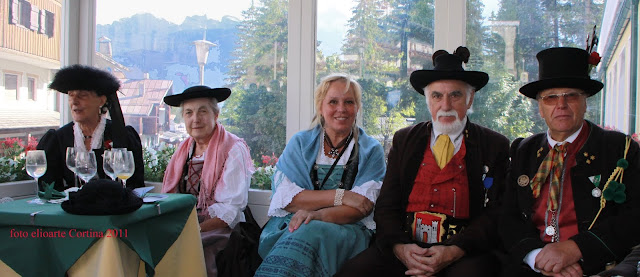Today I will talk about the costume of the French Province of Bourbonnais. This lies right in the center of the country, where the three major languages meet, Lenga d'òc of the south, Langue d'oïl of the north, and Arpitan of the east. The territory of the Province of Bourbonnais is mostly coterminous with the modern Departement of Allier.
http://en.wikipedia.org/wiki/Bourbonnais
A chemise, bloomers and petticoat form the foundation layer. Generally the only thing that shows is a collar which may be part of the chemise. Over this is a dress which may vary quite a bit. It opens in front, and is made in various colors and of various materials, depending on the season and the occasion. In the highlands of the southeastern part of this province, the bodice and skirt were separate, In the west, although sewn together, the bodice and skirt were often of different colors. The hem is generally about 20 cm above the sabot.
Here is one example. This is the work of the artist Victor Lhuer, who spent time in this region in the late 1800's, and left us an invaluable source of information about the costume.
The skirt is quite full, being flat in front, but gathered in folds on the sides and in back. The neckline varies. The apron also varies, sometimes it has pockets, and sometimes it hangs from the waist, as here, but usually it has a bib which is pinned to the bodice. Also notice in this image that the sleeves are smocked at the top. The skirt is pinned up on the sides, showing off the striped underskirt, which is worn over a linen petticoat.
A fichu is worn over the shoulders, under the pinafore, and is also pinned in place. For everyday it was of simple printed cotton, of wool for cooler weather, possibly of silk for more dressy occasions, and sometimes of fine linen with elaborate white embroidery. Notice that the bodice does not seem to have sleeves in this image, the blousy sleeves belonging to the chemise.
A linen cap, le bonnet, is worn, the back of which also has white on white embroidery. The edges may be decorated with goffered lace. Sometimes the collar lies flat and may also have ruched or goffered ornament.
A cross is almost always worn, often on a velvet ribbon. Knit stockings and sabot generally complete the ensemble. The sabots are sometimes carved, and are often painted black. They may have a leather strap over the arches, which is much more comfortable than the wooden edge.
This woman is holding the most famous part of the costume, the 'Chapeau à deux bonjours'.
This was not worn everywhere in the province, just from Moulin to Varennes, and from the Loire to the Forête de Tronçais, but has become a symbol of Bourbonnais.
It is a straw hat, with a truncated cone for a crown, the brim coming down at the sides, and raised both in front and in back. A 'bonjour' from the front, and another from the rear. It is lined with fabric, and trimmed with cloth, velvet ribbon and straw braid, somewhat like the Gorra of Montehermoso in Spain.
It was made on wooden forms, and so each location had a somewhat different shape. It is always worn over the coiffe.
The colors and the design executed by the straw ribbon varied considerably.
I do have one source which claims that a similar hat was worn as far north as Nevers in the Nivernais province of Bourgogne.
Just to show some of the local variety of costume, here is another type of coiffe. Notice the unusual way in which the sleeves are attached. You can also see how full the gathered skirt is behind.
In cooler or inclement weather, a cape is worn with this outfit which closes in front with a hook and chain.
The back of the cape is cut with a point that sticks out. This enables it to be worn over the hat like a hood if need be.
The men's costume has little that is distinctive, breeches, a shirt, a vest, jacket, neckcloth, knit stockings, sabot, and a hat with a large round brim for dress. As in other parts of France, gaiters were sometimes worn, see the photos at the end of the article.
A blue, round-necked smock for working or everyday over the shirt and breeches. Note the straw padding in the sabot.
The brim is sometimes so large that cords are attached from it to the peak to keep the brim from drooping.
Thank you for reading, I hope that you have found this interesting. I will close with more photos of this costume.

This group has committed a common error in making the aprons too small, and likely the skirts not full enough.
Here is a link to a video showing quite a good dance group performing dances from this area, mostly versions of Bouree.
Feel
free to contact me with requests for research. I hope to eventually
cover all of Europe and the Former Russian Empire/Soviet Union. I also
gratefully accept tips on source materials which i may not have. I also
accept commissions to research/design, sew, and/or embroider costumes
or other items for groups or individuals. I also choreograph and teach
folk dance.
Roman K.
Feel free to contact me at this email address.
Rkozakand@aol.comSource Material:
Lilla Fox, 'Folk Costumes of Western Europe',
Victor Lhuer, Le Costume Auvergnat et Bourbonnais', Equinoxe, 2001
Andre Sainsard, 'Costumes Folkloriques Provinces Françaises', Paris, 1972
Royere, Gardilanne, Moffat et al, 'Les Costumes Regionaux de la France', New York, 1929
Charles-Brun, 'Costumes des Provinces Françaises', Paris, 1937
P. Leroux, 'Costumes Regionaux', Paris, 1940
Caroline Brancq, 'Les Costumes regioneaux d'Autrefois', Paris, 2003









































































